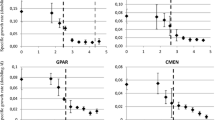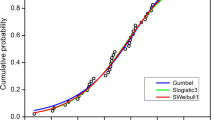Abstract
In recent years, herbicide sulfometuron-methyl (SM) has been used to kill the invasive plant Spartina alternflora in some coastal areas of China, which may lead to the toxic effects on non-target marine organisms. The 96-h median effective concentrations (96-h EC50) of SM on six species of marine microalgae were measured in growth inhibition tests, and were then compared with other published toxicity data, based on which a method of species sensitivity distribution (SSD) was built to estimate the hazardous concentration of SM for 5% of species (HC5) and potentially affected fraction (PAF) for a certain concentration. Results indicate that SM exhibited a high toxicity to two species of green algae (Chlorella pacifica and Dunaliella salina) with a 96-h EC50 of 0.11 and 0.13 mg/L respectively, had a medium toxicity to two species of golden algae (Diacronema viridis and Isochrysis galbana) with a 96-h EC50 of 14.24 and 21.48 mg/L respectively, and showed a low toxicity to two species of diatoms (Skeletonema costatum and Phaeodactylum tricornutum) with a 96-h EC50 of 148.99 and >100 mg/L, respectively. The estimated values of HC5 and the predicted no-effect concentrations (PNEC) for SM were 0.077 and 0.015 mg/L, respectively. According to the current dosage for killing S. alterniflora in tidal flats in Fujian Province, China, SM entering the sea by spraying might cause the acute injury or death of 14% of marine species. This hazard could last for about a month for those sensitive species. Therefore, on the premise of inhibiting the growth of this invasive plant, the dosage of SM should be reduced as much as possible to avoid severe damage to the marine ecosystem. The results provide a valuable information for marine ecological risk assessment on SM and for marine environmental management.
Similar content being viewed by others
Data Availability Statement
The data generated, or analyzed, during the current study are available from the corresponding author on reasonable request.
References
Adam N, Schmitt C, De Bruyn L et al. 2015. Aquatic acute species sensitivity distributions of ZnO and CuO nanoparticles. Science of the Total Environment, 526: 233–242, https://doi.org/10.1016/j.scitotenv.2015.04.064.
Aldenberg T, Luttik R. 2002. Extrapolation factors for tiny toxicity data sets from species sensitivity distributions with known standard deviation. In: Posthuma L, Suter II G W, Traas T P eds. Species Sensitivity Distributions in Ecotoxicology. Lewis Publishers, Boca Raton. p.103–108.
Baker B B, Haimbaugh A S, Sperone F G et al. 2022. Persistent contaminants of emerging concern in a great lakes urban-dominant watershed. Journal of Great Lakes Research, 48(1): 171–182, https://doi.org/10.1016/jjglr.2021.12.001.
Barron M G, Wharton S R. 2005. Survey of methodologies for developing media screening values for ecological risk assessment. Integrated Environmental Assessment and Management, 1(4): 320–332, https://doi.org/10.1002/ieam.5630010402.
Chaleff R S, Mauvais C J. 1984. Acetolactate synthase is the site of action of two sulfonylurea herbicides in higher plants. Science, 224(4656): 1443–1445, https://doi.org/10.1126/science.224.4656.1443.
Chen B L, Huang Q, Zhuang H R et al. 2004. Protective effect of Se against Zn toxicity on ultrastructure of Pavlova viridis Tseng (haptophyceae). Chinese Journal of Applied and Environmental Biology, 10(1): 60–63.
Crusciol C A C, Leite G H P, De Siqueira G F et al. 2017. Response of application of growth inhibitors on sugarcane productivity and sucrose accumulation in the middle of cropping season in Brazil. Sugar Tech, 19(2): 155–164, https://doi.org/10.1007/s12355-016-0450-1.
Da Silva Teófilo T M, Mendes K F, Fernandes B C C et al. 2020. Phytoextraction of diuron, hexazinone, and sulfometuron-methyl from the soil by green manure species. Chemosphere, 256: 127059, https://doi.org/10.1016/j.chemosphere.2020.127059.
Del Signore A, Hendriks A J, Lenders H J R et al. 2016. Development and application of the SSD approach in scientific case studies for ecological risk assessment. Environmental Toxicology Chemistry, 35(9): 2149–2161, https://doi.org/10.1002/etc.3474.
Du J G, Zhao J Y, Chen B et al. 2013. Assessing ecological risks of heavy metals to marine organisms by species sensitivity distributions. Asian Journal of Ecotoxicology, 8(4): 554–560. (in Chinese with English abstract)
Duan W Y, Meng F P, Lin Y F et al. 2017. Toxicological effects of phenol on four marine microalgae. Environmental Toxicology and Pharmacology, 52: 170–176, https://doi.org/10.1016/j.etap.2017.04.006.
EFSA Panel on Plant Protection Products and their Residues (PPR). 2013. Guidance on tiered risk assessment for plant protection products for aquatic organisms in edge-of-field surface waters. EFSA Journal, 11(7): 3290, https://doi.org/10.2903/j.efsa.2013.3290.
EN International Organization for Standardization (EN ISO). 2016. ISO 10253: 2016. Water quality—Marine algal growth inhibition test with Skeletonema sp. and Phaeodactylum tricornutum.
European Commission. 2003. Technical Guidance Document on Risk Assessment: Part II. Institute for Health and Consumer Protection.
Fahl G M, Kreft L, Altenburger R et al. 1995. pH-dependent sorption, bioconcentration and algal toxicity of sulfonylurea herbicides. Aquatic Toxicology, 31(2): 175–187, https://doi.org/10.1016/0166-445X(94)00067-Z.
Feng Y L. 2020. Investigation of model choice and minimum sampling size for species sensitivity distribution. Journal of Safety and Environment, 20(5): 1990–2000. (in Chinese with English abstract)
Fox D R, Van Dam R A, Fisher R et al. 2021. Recent developments in species sensitivity distribution modeling. Environmental Toxicology Chemistry, 40(2): 293–308, https://doi.org/10.1002/etc.4925.
Gao P, Li Z Y, Gibson M et al. 2014. Ecological risk assessment of nonylphenol in coastal waters of China based on species sensitivity distribution model. Chemosphere, 104: 113–119, https://doi.org/10.1016/j.chemosphere.2013.10.076.
Garrido S, Linares M, Campillo J A et al. 2019. Effect of microplastics on the toxicity of chlorpyrifos to the microalgae Isochrysis galbana, clone t-ISO. Ecotoxicology and Environmental Safety, 173: 103–109, https://doi.org/10.1016/j.ecoenv.2019.02.020.
Guillard R R L. 1975. Culture of phytoplankton for feeding marine invertebrates. In: Smith W L, Chanley M H eds. Culture of Marine Invertebrate Animals. Springer, Boston. p.29–60, https://doi.org/10.1007/978-1-4615-8714-9_3.
He J, He H Q, Yan Z G et al. 2019. Comparative analysis of freshwater species sensitivity distributions and ecotoxicity for priority pesticides: implications for water quality criteria. Ecotoxicology and Environmental Safety, 176: 119–124, https://doi.org/10.1016/j.ecoenv.2019.03.087.
He Q H, Lin Y Q, Tan H et al. 2020. Transcriptomic profiles of Dunaliella salina in response to hypersaline stress. BMC Genomics, 21(1): 115, https://doi.org/10.1186/s12864-020-6507-2.
HJ/T 154-2004. The guidelines for the hazard evaluation of new chemical substances. (in Chinese)
Kang Z H. 2012. The study on the microbial degradation of sulfometuron-methyl. Hebei Agricultural University, Baoding. (in Chinese)
Landstein D, Chipman D M, Arad S M et al. 1990. Acetohydroxy acid synthase activity in Chlorella emersonii under auto- and heterotrophic growth conditions. Plant Physiology, 94(2): 614–620, https://doi.org/10.1104/pp.94.2.614.
Liu M Y. 2018. Remote sensing analysis of Spartina alterniflora in the coastal areas of China during 1990 to 2015. Chinese Academy of Sciences (Northeast Institute of Geography and Agroecology, Chinese Academy of Sciences), Changchun. (in Chinese)
Lonhienne T, Low Y S, Garcia M D et al. 2020. Structures of fungal and plant acetohydroxyacid synthases. Nature, 586(7828): 317–321, https://doi.org/10.1038/s41586-020-2514-3.
Macedo R S, Lombardi A T, Omachi C Y et al. 2008. Effects of the herbicide bentazon on growth and photosystem II maximum quantum yield of the marine diatom Skeletonema costatum. Toxicology in Vitro, 22(3): 716–722, https://doi.org/10.1016/j.tiv.2007.11.012.
Magnusson M, Heimann K, Negri A P. 2008. Comparative effects of herbicides on photosynthesis and growth of tropical estuarine microalgae. Marine Pollution Bulletin. 56(9): 1545–1552, https://doi.org/10.1016/j-marpolbul.2008.05.023.
OECD. 2011. Test No. 201: freshwater alga and cyanobacteria, growth inhibition test. http://www.oecd-ilibrary.org/environment/test-no-201-alga-growth-inhibition-test_9789264069923-en. Accessed on 2022-01-13.
PAN. 2022. Sulfometuron methyl, https://www.pesticideinfo.org/chemical/PRI6028. Accessed on 2022-01-13.
Piccapietra F, Allué C G, Sigg L et al. 2012. Intracellular silver accumulation in Chlamydomonas reinhardtii upon exposure to carbonate coated silver nanoparticles and silver nitrate. Environmental Science & Technology, 46(13): 7390–7397, https://doi.org/10.1021/es300734m.
Qin N, He W, Kong X Z et al. 2013. Ecological risk assessment of polycyclic aromatic hydrocarbons (PAHs) in the water from a large Chinese lake based on multiple indicators. Ecological Indicators, 24: 599–608, https://doi.org/10.1016/j.ecolind.2012.08.019.
Schoeman W. 2007. Cellular Stress Responses to Cadmium Contamination as Measure of Sensitivity in Intertidal Molluscan Species. University of Stellenbosch, Stellenbosch.
Shao S Y, Wu J Y, Meng F P et al. 2022. Natural attenuation of sulfometuron-methyl in seawater: kinetics, intermediates, toxicity change and ecological risk assessment. Journal of Environmental Management, 313: 114980, https://doi.org/10.1016/j.jenvman.2022.114980.
Soto J O. 2015. Dunaliella identification using DNA fingerprinting intron-sizing method and species-specific oligonucleotides: new insights on Dunaliella molecular identification. In: Kim S K ed. Handbook of Marine Microalgae. Elsevier, Amsterdam. p.559–568, https://doi.org/10.1016/b978-0-12-800776-1.00038-8.
Sverdrup L E, Källqvist T, Kelley A E et al. 2001. Comparative toxicity of acrylic acid to marine and freshwater microalgae and the significance for environmental effects assessments. Chemosphere, 45(4–5): 653–658, https://doi.org/10.1016/S0045-6535(01)00044-3.
Tanaka Y, Yoshikawa H. 1998. Inhibition of acetolactate synthase in plants by imazosufuron. Journal of Weed Science and Technology, 43(4): 291–299, https://doi.org/10.3719/weed.43.291.
TenBrook P L, Tjeerdema R S, Hann P et al. 2009. Methods for deriving pesticide aquatic life criteria. In: Whitacre D M ed. Reviews of Environmental Contamination and Toxicology. Springer, Boston. p. 1–92, https://doi.org/10.1007/978-0-387-09808-1_2.
Thiagarajan V, Pavani M, Archanaa S et al. 2019. Diminishing bioavailability and toxicity of P25 TiO2 NPs during continuous exposure to marine algae Chlorella sp. Chemosphere, 233: 363–372, https://doi.org/10.1016/j.chemosphere.2019.05.270.
USEPA. 2012. OCSPP 850.4500: Algal Toxicity [EPA 712-C-006]. https://www.regulations.gov/document/EPA-HQ-OPPT-2009-0154-0003. Accessed on 2022-01-13.
USEPA. 2022. Pesticide ecotoxicity database (formerly: environmental effects database), https://cfpub.epa.gov/ecotox/search.cfm. Accessed on 2023-01-30.
Van Den Brink P J, Buijert-De Gelder D M, Brock T C M et al. 2019. Exposure pattern-specific species sensitivity distributions for the ecological risk assessments of insecticides. Ecotoxicology and Environmental Safety, 180: 252–258, https://doi.org/10.1016/j.ecoenv.2019.05.022.
Vidal T, Santos J I, Queirós L et al. 2019. Environmental benchmarks based on ecotoxicological assessment with planktonic species might not adequately protect benthic assemblages in lotic systems. Science of the Total Environment, 668: 1289–1297, https://doi.org/10.1016/j.scitotenv.2019.03.067.
Wang L F. 2017. Study on the damage and control technology of Spartina alterniflora in Xiapu County. China Agricultural Information, (17): 87–89. (in Chinese)
Wang Q, Ge L A, Zhao N et al. 2019. A Trp-574-Leu mutation in the acetolactate synthase (ALS) gene of Lithospermum arvense L. confers broad-spectrum resistance to ALS inhibitors. Pesticide Biochemistry and Physiology, 158: 12–17, https://doi.org/10.1016/j.pestbp.2019.04.001.
Wang Y L, Zeng Z H. 2014. Toxicity of sulfometuron-methyl to beach wetland animals. Chemical Engineering & Equipment, (2): 17–19. (in Chinese with English abstract)
Weyers A, Vollmer G. 2000. Algal growth inhibition: effect of the choice of growth rate or biomass as endpoint on the classification and labelling of new substances notified in the EU. Chemosphere, 41(7): 1007–1010, https://doi.org/10.1016/S0045-6535(99)00518-4.
Xu F L, Li Y L, Wang Y et al. 2015. Key issues for the development and application of the species sensitivity distribution (SSD) model for ecological risk assessment. Ecological Indicators, 54: 227–237, https://doi.org/10.1016/j.ecolind.2015.02.001.
Yang L Q, Li H M, Zhang Y Y et al. 2019. Environmental risk assessment of triazine herbicides in the Bohai Sea and the Yellow Sea and their toxicity to phytoplankton at environmental concentrations. Environment International, 133: 105175, https://doi.org/10.1016/j.envint.2019.105175.
Yi X, Feng W H, Sun S X et al. 2004. Influence of sulfometuron methyl in groundwater on crops. Journal of Agro-Environment Science, 23(1): 186–189. (in Chinese with English abstract)
Zhang D H, Hu Y M, Liu M et al. 2017. Introduction and spread of an exotic plant, Spartina alterniflora, along coastal marshes of China. Wetlands, 37(6): 1181–1193, https://doi.org/10.1007/s13157-017-0950-0.
Zhao J S, Chen B Y. 2016. Species sensitivity distribution for chlorpyrifos to aquatic organisms: model choice and sample size. Ecotoxicology and Environmental Safety, 125: 161–169, https://doi.org/10.1016/j.ecoenv.2015.11.039.
Author information
Authors and Affiliations
Corresponding author
Additional information
Supported by the National Natural Science Foundation of China (No. 42077335)
Rights and permissions
About this article
Cite this article
Liu, J., Meng, F., Du, S. et al. Marine ecological risk assessment for the herbicide sulfometuron-methyl based on species sensitivity distribution approach. J. Ocean. Limnol. 41, 1493–1503 (2023). https://doi.org/10.1007/s00343-022-2074-5
Received:
Accepted:
Published:
Issue Date:
DOI: https://doi.org/10.1007/s00343-022-2074-5




